
The Denys Wilkinson Building is a prominent 1960s building in Oxford, England, designed by Philip Dowson at Arup in 1967. [1]

The Denys Wilkinson Building is a prominent 1960s building in Oxford, England, designed by Philip Dowson at Arup in 1967. [1]
The building houses the astrophysics and particle physics sub-departments of the Department of Physics at Oxford University, plus the undergraduate teaching laboratories. It was originally built for the then Department of Nuclear Physics and named the Nuclear Physics Laboratory. [2] From 1988, the building was known as the Nuclear and Astrophysics Laboratory (NAPL) after the (Sub-)Department of Astrophysics moved from the University Observatory in the Science Area. In 2001, the building was renamed as the Denys Wilkinson Building, [3] in honour of the British nuclear physicist Sir Denys Wilkinson (1922–2016), who was involved in its original creation.

The building is located on the corner of Banbury Road to the west and Keble Road to the south. To the north is the tall Thom Building of Oxford University's Department of Engineering Science, also built in the 1960s. It forms part of the Keble Road Triangle. [2] Attached is a large and distinctive fan-shaped superstructure that was built to house a Van de Graaff generator. Nikolaus Pevsner commented that this marked "the arrival of the 'New Brutalism' in Oxford". [1]


The building was originally built to host two small (by today's standards) particle accelerators.[ citation needed ]
The first was a vertical folded tandem electrostatic accelerator (see Tandem accelerators, the top being at floor level in the fan-shaped superstructure, the bottom in the basements. Negatively charged ions were introduced at the bottom and would be accelerated towards the large charge (10 million volts) built up by the Van de Graaff generator by electrostatic attraction. At the top, the ions would pass through a thin foil to strip off electrons, and then their trajectory would be bent 180° by a large magnetic field. The now positively charged nuclei would then be electrostatically repelled by the same charge, accelerating them back down another vacuum tube. At the bottom the beam pipe exited, the beam was bent 90° by another magnet before entering a linear accelerator.
This particular accelerator consisted of a pressure vessel, about 40 feet tall, containing an annular lift/elevator platform to enable work to be carried out at different levels inside. Stacked in the centre was the accelerator column, comprising the Van de Graaff generator (a thick, rubber/canvas belt approximately 2 feet wide), the up/down vacuum tubes, and the electron stripper and magnet systems on top. The magnet was powered by a generator driven the by Van de Graaff belt. The column was surrounded by electrostatic discharge protection rings, in case of sparks. The whole column was resting on glass bricks at the bottom, with no lateral supports whatsoever.
The pressure vessel was filled with sulphur hexafluoride gas. The storage tank for this was located outside on the eastern side of the building. The gas served as an insulator, allowing higher voltages on the Van de Graaff generator to be run resulting in greater particle energies being attained than if air had been used. It also served as a fire suppressant, in the event of a spark discharge (which, when they did occur, was described as being "very loud indeed"). The sulphur hexafluoride was sourced from a company in Italy, and occasionally shipments of "bombola di gas" addressed to the "Nuclear Physics Department" Oxford would get stuck on the Italian/French border.
This was an RF resonant cavity accelerator and would add additional energy to the nuclei. It was located down in a basement. On exiting the accelerator the nuclei would drift to a target station for experiments. The particle energy at the target station was about 22MeV.
In the late 1980s, this accelerator was sold to Beijing University. To extract it holes had to be cut through the floor of the covered loading dock located at the north side of the building all the way down to the lowest basement.
The accelerators were intended to support research into nuclear structure, a field that was popular at the time of the building's construction. However, it was discovered that the field was extremely complex and progress was slow. The field was overtaken by other fields in nuclear physics, and the accelerators in the Denys Wilkinson Building fell into disuse.
The building was designed around conducting particle physics. The bulk of the accelerator infrastructure and experimental target station is in basement levels. The walls of the building at the lower levels are very thick concrete and are laden with boron. This was to keep the natural background radiation count inside the building as low as possible, and not (as was the popular and local civic belief) to keep radiation in. Some of the more exposed parts of the building suffered from rebar corrosion.[ citation needed ]
The building was originally going to be further extended on the eastern side, but the funding never became available.[ citation needed ]
In the 1970s and 1980s, the building's basement was also designated as the emergency shelter for Oxford City Council.[ citation needed ] There was occasionally tension with the local council, which periodically tried to shut down the "Nuclear Physics Department" of the university. Generally, such tensions were resolved with arranged visits, and explanations as to the role it would also serve for the councillors in the event of a nuclear attack on the United Kingdom.
The John Adams Institute for Accelerator Science (JAI), named for John Adams (physicist), is located in the building. [4] The JAI was established in 2004 as a joint venture between the Departments of Physics at Oxford [5] and Royal Holloway University of London, [6] with Imperial College London [7] joining the venture in 2011. [8]

A cyclotron is a type of particle accelerator invented by Ernest Lawrence in 1929–1930 at the University of California, Berkeley, and patented in 1932. A cyclotron accelerates charged particles outwards from the center of a flat cylindrical vacuum chamber along a spiral path. The particles are held to a spiral trajectory by a static magnetic field and accelerated by a rapidly varying electric field. Lawrence was awarded the 1939 Nobel Prize in Physics for this invention.
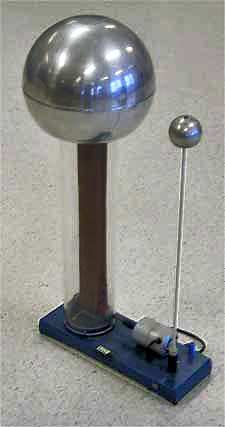
A Van de Graaff generator is an electrostatic generator which uses a moving belt to accumulate electric charge on a hollow metal globe on the top of an insulated column, creating very high electric potentials. It produces very high voltage direct current (DC) electricity at low current levels. It was invented by American physicist Robert J. Van de Graaff in 1929. The potential difference achieved by modern Van de Graaff generators can be as much as 5 megavolts. A tabletop version can produce on the order of 100 kV and can store enough energy to produce visible electric sparks. Small Van de Graaff machines are produced for entertainment, and for physics education to teach electrostatics; larger ones are displayed in some science museums.

Robert Jemison Van de Graaff was an American physicist, noted for his design and construction of high-voltage Van de Graaff generators. He spent most of his career in the Massachusetts Institute of Technology (MIT).
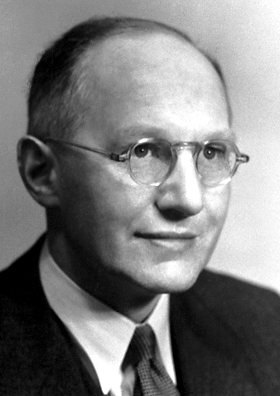
Ernest Thomas Sinton WaltonMRIA was an Irish physicist and Nobel laureate who first split the atom. He is best known for his work with John Cockcroft to construct one of the earliest types of particle accelerator, the Cockcroft–Walton generator. In experiments performed at Cambridge University in the early 1930s using the generator, Walton and Cockcroft became the first team to use a particle beam to transform one element to another. According to their Nobel Prize citation: "Thus, for the first time, a nuclear transmutation was produced by means entirely under human control".

TRIUMF is Canada's national particle accelerator centre. It is considered Canada's premier physics laboratory, and consistently regarded as one of the world's leading subatomic physics research centres. Owned and operated by a consortium of universities, it is on the south campus of one of its founding members, the University of British Columbia in Vancouver, British Columbia, Canada. It houses the world's largest normal conducting cyclotron, a source of 520 MeV protons, which was named an IEEE Milestone in 2010. Its accelerator-focused activities involve particle physics, nuclear physics, nuclear medicine, materials science, and detector and accelerator development.
Oscar Sala, Italian-Brazilian nuclear physicist and important scientific leader, Emeritus Professor of the Institute of Physics, University of São Paulo.

A Pelletron is a type of electrostatic generator, structurally similar to a Van de Graaff generator. Pelletrons have been built in many sizes, from small units producing voltages up to 500 kilovolts (kV) and beam energies up to 1 megaelectronvolt (MeV) of kinetic energy, to the largest system, which has reached a DC voltage of over 25 megavolts and produced ion beams with energies over 900 MeV.
The Research School of Physics (RSPhys) was established with the creation of the Australian National University (ANU) in 1947. Located at the ANU's main campus in Canberra, the school is one of the four founding research schools in the ANU's Institute of Advanced Studies.

Electron scattering occurs when electrons are displaced from their original trajectory. This is due to the electrostatic forces within matter interaction or, if an external magnetic field is present, the electron may be deflected by the Lorentz force. This scattering typically happens with solids such as metals, semiconductors and insulators; and is a limiting factor in integrated circuits and transistors.

Keble Road is a short road running east–west in central Oxford, England. To the west is the southern end of the Banbury Road with St Giles' Church opposite. To the east is Parks Road with the University Parks opposite. Blackhall Road leads off the road to the south near the western end.
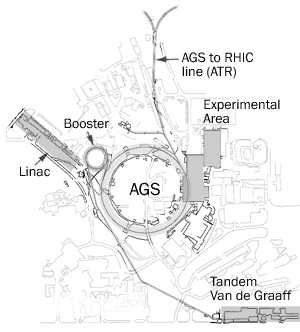
The Alternating Gradient Synchrotron (AGS) is a particle accelerator located at the Brookhaven National Laboratory in Long Island, New York, United States.
The Triangle Universities Nuclear Laboratory, abbreviated as TUNL, is a tripartite research consortium operated by Duke University, the University of North Carolina at Chapel Hill, North Carolina State University and North Carolina Central University. The laboratory is located on the West Campus of Duke University in Durham, North Carolina. Researchers are now drawn from several other universities around the United States in addition to members from the founding universities. TUNL also participates in long term collaborations with universities and laboratories around the world. Funding for TUNL comes primarily from the United States Department of Energy Office of Nuclear Physics.

Old Engineering Hall is an academic building at 3943 O'Hara Street on the campus of the University of Pittsburgh in Pittsburgh, Pennsylvania, United States. The building was completed for $1.2 million($13.6 million today) in October, 1955. The seven floor building connects Allen Hall and Thaw Hall, as well as the Van de Graaff Building which was added later. The frieze around the top of the building includes bas-relief of the insignia of several engineering societies. Originally called Engineering Hall, it initially contained engineering offices, classrooms, laboratories, a library, and in the basement, a wind tunnel for the aeronautical engineering department testing of airfoil surfaces.
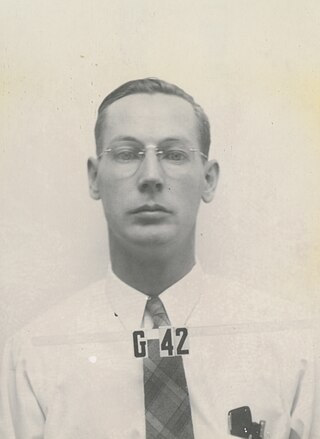
Donald William Kerst was an American physicist who worked on advanced particle accelerator concepts and plasma physics. He is most notable for his development of the betatron, a novel type of particle accelerator used to accelerate electrons.

A particle accelerator is a machine that uses electromagnetic fields to propel charged particles to very high speeds and energies to contain them in well-defined beams. Large accelerators are used for fundamental research in particle physics. Accelerators are also used as synchrotron light sources for the study of condensed matter physics. Smaller particle accelerators are used in a wide variety of applications, including particle therapy for oncological purposes, radioisotope production for medical diagnostics, ion implanters for the manufacture of semiconductors, and accelerator mass spectrometers for measurements of rare isotopes such as radiocarbon.

An electrostatic particle accelerator is a particle accelerator in which charged particles are accelerated to a high energy by a static high voltage potential. This contrasts with the other major category of particle accelerator, oscillating field particle accelerators, in which the particles are accelerated by oscillating electric fields.

The Westinghouse Atom Smasher was a 5 million volt Van de Graaff electrostatic nuclear accelerator operated by the Westinghouse Electric Corporation at their Research Laboratories in Forest Hills, Pennsylvania. It was instrumental in the development in practical applications of nuclear science for energy production. In particular, it was used in 1940 to discover the photofission of uranium and thorium, and was most cited for certain nuclear physics measurements. The Westinghouse Atom Smasher was able to make precise measurements of nuclear reactions for research in nuclear power. It was the first industrial Van de Graaff generator in the world, and marked the beginning of nuclear research for civilian applications. Built in 1937, it was a 65-foot-tall (20 m) pear-shaped tower. It went dormant in 1958. In 1985, it was named an Electrical Engineering Milestone by the Institute of Electrical and Electronics Engineers.
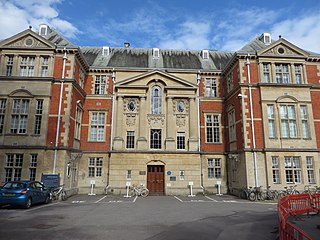
The Department of Physics at the University of Oxford is located on Parks Road in Oxford, England. The department consists of multiple buildings and sub-departments including the Clarendon Laboratory, Denys Wilkinson's building, Dobson Square and the Beecroft building. Each of these facilities contribute in studying different sub-types of physics such as Atomic and Laser Physics, Astrophysics, Theoretical Physics, etc. The physics division have made scientific contributions towards this branch of science since the establishment of the department.
Yale Wright Laboratory (Wright Lab) is a facility and research community at Yale University in New Haven, CT. Wright Lab enables researchers to develop, build and use research instrumentation for experiments in nuclear, particle and astrophysics across the globe that investigate the invisible universe. Before a transformation to its current purpose in 2017, Wright Lab was known as the Arthur W. Wright Nuclear Structure Laboratory (WNSL). WNSL housed the first "Emperor" tandem Van de Graaff heavy ion accelerator and was founded by D. Allan Bromley, the "father of heavy-ion physics," in 1961 (see History, below, for more information).
Thomas Lauritsen was an American nuclear physicist best known for his abilities at designing and building experimental facilities and instrumentation for experimental nuclear physics; and as the longtime co-author of a periodic compilation of nuclear data. Except for brief periods abroad, his career was entirely at the California Institute of Technology, mostly as a professor of physics. In 1969 he was elected as a member of the National Academy of Sciences and also the American Academy of Arts and Sciences.